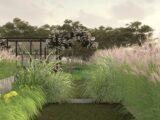Grass plays an essential role in landscaping, agriculture, and ecological balance. For many homeowners, farmers, and gardeners, choosing the right type of grass is crucial for achieving a lush, green lawn or pasture.
This comprehensive guide explores various types of grass, their unique characteristics, and how to care for them. Whether you’re a novice gardener or an experienced landscaper, this guide will provide valuable insights to help you make informed decisions.
Introduction to Grass Types

Grasses are classified into two main categories: cool-season grasses and warm-season grasses. These classifications are based on the grass’s optimal growth temperatures.
Cool-Season Grasses
Cool-season grasses thrive in temperatures between 60°F and 75°F. They are typically found in regions with cool summers and cold winters. Some of the most common cool-season grasses include:
- Kentucky Bluegrass (Poa pratensis)
- Perennial Ryegrass (Lolium perenne)
- Tall Fescue (Festuca arundinacea)
- Fine Fescue (Festuca spp.)
Warm-Season Grasses
Warm-season grasses flourish in temperatures between 80°F and 95°F. They are ideal for regions with hot summers and mild winters. Common warm-season grasses include:
- Bermuda Grass (Cynodon dactylon)
- Zoysia Grass (Zoysia spp.)
- St. Augustine Grass (Stenotaphrum secundatum)
- Centipede Grass (Eremochloa ophiuroides)
Detailed Overview of Grass Types
1. Kentucky Bluegrass
Kentucky Bluegrass is renowned for its vibrant green color and fine texture. It is a cool-season grass that is often used in lawns, parks, and sports fields.
- Growth Habit: Rhizomatous (spreads through underground stems)
- Ideal Climate: Cool, temperate regions
- Maintenance: Requires regular watering and fertilization
- Common Uses: Lawns, golf courses, athletic fields
2. Perennial Ryegrass
Perennial Ryegrass is a cool-season grass known for its quick germination and establishment. It is often used in overseeding warm-season lawns to maintain green color during cooler months.
- Growth Habit: Bunch-type (grows in clumps)
- Ideal Climate: Cool, moist regions
- Maintenance: Moderate watering and fertilization
- Common Uses: Lawns, sports fields, erosion control
3. Tall Fescue
Tall Fescue is a versatile cool-season grass that can withstand various soil conditions and drought.
- Growth Habit: Bunch-type
- Ideal Climate: Cool to warm regions
- Maintenance: Low to moderate watering; deep roots provide drought resistance
- Common Uses: Lawns, pastures, roadsides
4. Fine Fescue
Fine Fescue comprises several species, including creeping red fescue, hard fescue, and chewings fescue. These grasses are known for their fine texture and shade tolerance.
- Growth Habit: Bunch-type and rhizomatous
- Ideal Climate: Cool, shaded areas
- Maintenance: Low watering and fertilization
- Common Uses: Lawns, shaded landscapes, naturalized areas
5. Bermuda Grass
Bermuda Grass is a warm-season grass valued for its durability and heat tolerance. It is commonly used in lawns, golf courses, and athletic fields.
- Growth Habit: Rhizomatous and stoloniferous (spreads through underground and above-ground stems)
- Ideal Climate: Hot, sunny regions
- Maintenance: Regular mowing, moderate to high watering
- Common Uses: Lawns, sports fields, golf courses
6. Zoysia Grass
Zoysia Grass is a warm-season grass known for its dense growth and ability to tolerate foot traffic.
- Growth Habit: Rhizomatous and stoloniferous
- Ideal Climate: Warm, temperate regions
- Maintenance: Low to moderate watering, infrequent mowing
- Common Uses: Lawns, golf courses, recreational areas
7. St. Augustine Grass
St. Augustine Grass is a warm-season grass prized for its ability to thrive in coastal regions and shady areas.
- Growth Habit: Stoloniferous
- Ideal Climate: Warm, humid regions
- Maintenance: Moderate watering, high salt tolerance
- Common Uses: Lawns, coastal landscapes, shaded areas
8. Centipede Grass
Centipede Grass is a low-maintenance warm-season grass that is slow-growing and ideal for homeowners seeking an easy-care lawn.
- Growth Habit: Stoloniferous
- Ideal Climate: Warm, humid regions
- Maintenance: Low watering, minimal fertilization
- Common Uses: Lawns, parks, cemeteries
Choosing the Right Grass for Your Lawn
Selecting the right type of grass depends on several factors, including your region’s climate, soil type, and intended use of the lawn. Here are some considerations to help you make an informed decision:
Climate Considerations
- Cool-Season Regions: Opt for grasses like Kentucky Bluegrass, Perennial Ryegrass, or Tall Fescue.
- Warm-Season Regions: Choose grasses such as Bermuda Grass, Zoysia Grass, or Centipede Grass.
Soil Type
- Sandy Soils: Bermuda Grass and Centipede Grass perform well.
- Clay Soils: Tall Fescue and Zoysia Grass are suitable choices.
- Loamy Soils: Most grass types thrive, but Fine Fescue and Kentucky Bluegrass are excellent options.
Sunlight and Shade
- Full Sun: Bermuda Grass and Zoysia Grass are ideal.
- Partial Shade: St. Augustine Grass and Fine Fescue are good choices.
Maintenance Level
- Low Maintenance: Centipede Grass and Tall Fescue require minimal upkeep.
- High Maintenance: Kentucky Bluegrass and Bermuda Grass need regular care and attention.
Seasonal Care Guide
Proper maintenance throughout the year is essential for a healthy lawn. Here’s a seasonal care guide for common grass types:
Cool-Season Grass Care
| Month | Task |
|---|---|
| Jan | Dormant |
| Feb | Dormant |
| Mar | Fertilize, Aerate |
| Apr | Seed, Water |
| May | Mow, Fertilize |
| Jun | Water, Mow |
| Jul | Water, Mow |
| Aug | Water, Mow |
| Sep | Fertilize, Seed |
| Oct | Water, Mow |
| Nov | Mow, Aerate |
| Dec | Dormant |
Warm-Season Grass Care
| Month | Task |
|---|---|
| Jan | Dormant |
| Feb | Dormant |
| Mar | Fertilize, Water |
| Apr | Seed, Water |
| May | Mow, Fertilize |
| Jun | Water, Mow |
| Jul | Water, Mow |
| Aug | Water, Mow |
| Sep | Fertilize, Water |
| Oct | Mow, Water |
| Nov | Dormant |
| Dec | Dormant |
Common Issues and Solutions
Even with proper care, lawns can face various issues. Here are some common problems and solutions:
Weeds
- Problem: Unwanted plants competing with grass.
- Solution: Apply pre-emergent herbicides in early spring and post-emergent herbicides as needed.
Pests
- Problem: Insects damaging the grass.
- Solution: Use insecticides and promote beneficial insects like ladybugs.
Diseases
- Problem: Fungal infections causing brown patches or mold.
- Solution: Ensure proper watering, improve air circulation, and apply fungicides if necessary.
Thatch
- Problem: A layer of dead grass and roots that prevents water and nutrients from reaching the soil.
- Solution: Dethatch the lawn using a dethatching rake or machine.
Watering Tips
Proper watering is crucial for maintaining a healthy lawn. Here are some tips to ensure your grass gets the right amount of water:
- Early Morning Watering: Water your lawn early in the morning to reduce evaporation and allow grass blades to dry before evening, reducing the risk of disease.
- Deep and Infrequent Watering: Water deeply and infrequently to encourage deep root growth, which improves drought resistance.
- Adjust for Seasons: During cooler months, reduce watering frequency. Increase it during hot, dry periods.
Mowing Guidelines
Mowing is more than just cutting grass; it’s about promoting healthy growth. Follow these guidelines for optimal mowing:
- Mow at the Right Height: Different grasses have different ideal mowing heights. For example, Bermuda Grass should be mowed to 1-2 inches, while Tall Fescue should be kept at 2.5-3.5 inches.
- Keep Blades Sharp: Sharp mower blades prevent tearing, which can damage the grass and make it more susceptible to disease.
- Follow the One-Third Rule: Never cut more than one-third of the grass height at a time. This helps prevent stress and maintains a healthy lawn.
Fertilization Best Practices
Fertilizing your lawn provides essential nutrients that promote growth and health. Here are some fertilization tips:
- Choose the Right Fertilizer: Use a balanced fertilizer with a ratio suitable for your grass type. For example, a 3-1-2 ratio (nitrogen-phosphorus-potassium) is often recommended.
- Apply at the Right Time: For cool-season grasses, fertilize in early spring and fall. For warm-season grasses, fertilize in late spring and summer.
- Follow Application Rates: Over-fertilizing can harm your lawn and the environment. Always follow the recommended application rates on the fertilizer packaging.
Aeration Techniques
Aeration involves perforating the soil with small holes to allow air, water, and nutrients to penetrate the grassroots. This process is essential for maintaining lawn health, especially in compacted soils.
- When to Aerate: Aerate cool-season grasses in early spring or fall and warm-season grasses in late spring or early summer.
- How to Aerate: Use a core aerator that removes small plugs of soil, creating space for root growth and improving soil structure.
Seeding and Overseeding
Seeding and overseeding are crucial for establishing a new lawn or rejuvenating an existing one. Follow these steps for successful seeding:
- Prepare the Soil: Remove debris, loosen the soil, and add compost to improve soil quality.
- Choose Quality Seed: Select a grass seed that suits your climate and soil type.
- Spread Evenly: Use a broadcast spreader to distribute the seed evenly.
- Water Consistently: Keep the soil consistently moist until the grass is established.
Lawn Care Tools and Equipment
Having the right tools can make lawn care easier and more effective. Here are some essential tools for maintaining your lawn:
- Lawn Mower: Choose a mower that suits your lawn size and grass type.
- Aerator: A core aerator is essential for soil health.
- Spreader: A broadcast spreader ensures even distribution of seed and fertilizer.
- Rake: A good rake helps with dethatching and debris removal.
Environmental Benefits of a Healthy Lawn
Maintaining a healthy lawn offers several environmental benefits:
- Air Quality: Grass absorbs carbon dioxide and releases oxygen, improving air quality.
- Erosion Control: A dense lawn prevents soil erosion by holding the soil in place.
- Water Filtration: Grass filters rainwater, reducing runoff and improving groundwater quality.
- Temperature Regulation: Lawns can cool the surrounding air, reducing the heat island effect in urban areas.
Conclusion
Understanding the different types of grass and their specific care requirements is essential for creating and maintaining a beautiful, healthy lawn. By considering factors such as climate, soil type, and maintenance level, you can choose the right grass for your needs. Regular care, including proper watering, mowing, fertilization, and aeration, will ensure your lawn remains lush and vibrant throughout the year.
Investing time and effort into your lawn not only enhances the aesthetic appeal of your property but also provides significant environmental benefits. With this comprehensive guide, you are well-equipped to make informed decisions and achieve a thriving lawn that will be the envy of your neighborhood.



